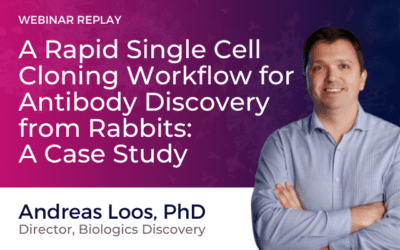
A Rapid Single Cell Cloning Workflow for Antibody Discovery from Rabbits: A Case Study
Presented by Andreas Loos, PhD, Director Biologics Discovery at ChemPartner.
In this webinar, Dr. Loos will discuss the rapid single B-cell cloning workflow that ChemPartner is using to discover rabbit antibodies. After a quick primer on the technical equipment used (Beacon), we use an internal anti-CD28 (cluster of differentiation 28) rabbit antibody discovery case study to go over the individual steps of the rabbit workflow.
Join this webinar to gain an understanding of the Beacon system, the scientific background of the workflow, as well as an overview of the characteristics of the antibodies discovered in this case study.
Who Should Attend?
This webinar will appeal to:
- Biologics Discovery Scientists
- Upper management who will decide on the discovery modality for an antibody program
- Scientists interested in antibody discovery
What You Will Learn
Attendees will gain insights into:
- Rabbit antibody discovery using the Beacon single-cell cloning process
- The scientific background of the workflow
- An overview of the characteristics of the antibodies discovered in this case study
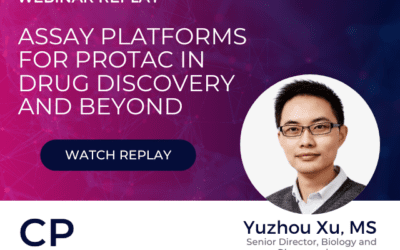
Assay Platforms for PROTAC in Drug Discovery and Beyond
Presented by Yuzhou Xu, Senior Director of Biology and Pharmacology at ChemPartner.
Abstract: Discover a groundbreaking webinar delving into the in vitro assays for proteolysis targeting chimera (PROTAC). PROTACs are being developed more and more for many kinds of target proteins, even for “undruggable targets.”
A PROTAC is a heterobifunctional molecule that utilizes the ubiquitin-proteasome system (UPS) to degrade a target protein. The simultaneous binding of the target protein and ligase by the PROTAC induces ubiquitylation of the target protein. Afterward, the target protein is subsequently degraded by the UPS. Then the PROTAC is recycled to target another target protein. This novel, catalytic-type mechanism of action is called “event-driven” pharmacology, which contrasts with “occupancy-driven” pharmacology, whereby the function of a target protein is directly blocked by a small-molecule inhibitor.
The ubiquitin-mediated destruction of cellular proteins plays a crucial part in many cellular functions by altering the cellular protein concentration. The discovery of specific proteins that are ubiquitylated before degradation in the 1970s led to the 2004 Nobel Prize in chemistry.
Since then, with the catalytically “event-driven” pharmacology, the potency of binding affinity to the target protein is no longer the key aspect of a PROTAC. However, more insights and better assays to help the structure-activity relationship (SAR) for PROTACs are needed.
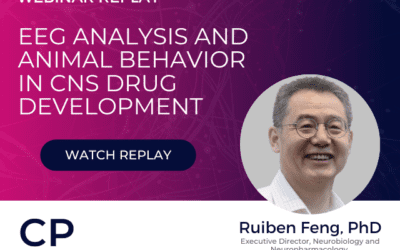
EEG Analysis and Animal Behavior in CNS Drug Development
Presented by Ruiben Feng, PhD, Executive Director, Neurobiology and Neuropharmacology at Shanghai ChemPartner.
Abstract:
EEG analysis (Electroencephalography) is becoming a promising translatable biomarker for predicting the likelihood that novel therapies and compounds will exhibit clinical efficacy early in preclinical development. EEG and relevant analyses have been very useful in the drug development process in the context of several major central nervous system (CNS) diseases including Alzheimer’s disease, epilepsy, sleep/wake disorders, schizophrenia, depression, attention deficit, hyperactivity disorder, and pain. Additionally, EEG-based signatures represent promising preclinical screens to quickly determine CNS penetration, drug-target engagement, evidence of efficacy, pharmacokinetic/pharmacodynamic profile, CNS safety and toxicity, and pro-convulsant risk.
In this webinar, the featured speaker will review the EEG analysis, related optimization parameters, and candidate compound selection as well as case studies where EEG-based signatures in correlation with animal behavior could validate the EEG as the endpoint for a set of translatable biomarkers bridging preclinical and clinical programs.
Join this webinar to gain insights into EEG analysis as physiological endpoints to facilitate drug discovery for CNS diseases.

Biological Macromolecules: Exploring Analytical Development and QC Case Studies in Antibody Developability and Biologics CMC
Presented by Dr. Jinghan Su, Assistant Director and Head of Developability, and Dr. Qian Sun, Director, Head of Analytical Development and Quality Control at ChemPartner.
Abstract:
Biological macromolecules (monoclonal antibodies, recombinant proteins, fusion proteins, antibody-drug-conjugates, polypeptides and vaccines, etc.) are powerful therapeutics, and their characterization has drawn considerable attention and urgency in the biopharmaceutical industry. A developability assessment at an early stage can provide a better understanding of candidates, deliver better and safer therapeutic candidates and reduce risk during late-stage development.
- Antibody quality attributes that are critical to development and traditional and state-of-the-art analytical methods to monitor those attributes
- A practical workflow for developability assessment, including in silico evaluation, extended characterization and preliminary stability studies using appropriate analytical methods
- Case studies on conducting developability assessment experiments

Rapid Discovery of a Diverse Panel of Antibodies Against Membrane Targets Using the Beacon System
Presented by Dr. Shireen Khan, Senior Director of Biologics at ChemPartner and Dina Sirypangno, Senior Technical Sales Specialist at Berkeley Lights
Abstract:
Traditional antibody discovery technologies have been used to develop all FDA-approved antibody therapeutics currently in the clinic for diseases including autoimmune, inflammatory, infectious diseases, and cancer. However, the next-generation of antibody therapies against more challenging targets, such as membrane-bound receptors, will require new technologies that can screen the broad B cell repertoire in depth.
Dr. Shireen Khan presents a case study of how ChemPartner has leveraged the Beacon system to rapidly discover cross-reactive antibodies against the GPI-anchored urokinase plasminogen activator (uPA) receptor. uPA and its receptor uPAR are associated with aggressive forms of cancer including metastatic breast cancer and pancreatic ductal adenocarcinomas. The upregulation of uPA in cancer was shown to correlate with poor clinical prognosis and supports targeting this pathway as a therapeutic approach for tumors in which uPA/uPAR are tumorigenic drivers. Identification of crossreactive antibodies to human, cyno, and mouse uPAR proved to be challenging by panning a Fab phage display library against human uPAR.
In collaboration with UCSF and SPII, ChemPartner leveraged the Berkeley Lights’ Beacon optofluidic system to screen deeper into the immune B cell repertoire. Single B cells were screened on the Beacon system using a novel multiplexed assay for human, mouse, and cyno uPAR binders. Antibodies were identified that bound both human and cyno uPAR proteins and represented broad sequence diversity. After generating the antibodies through recombinant antibody expression and purification, several candidates were strong binders to human uPAR on endogenously expressing MDA-MB-231 breast cancer cells. Functional characterization of these antibodies in uPA/uPAR blocking, pERK signaling, and invasion assays is underway. Dina Sirypangno shares new capabilities developed at Berkeley Lights to enable better antibody lead candidate selection in under 1 week.
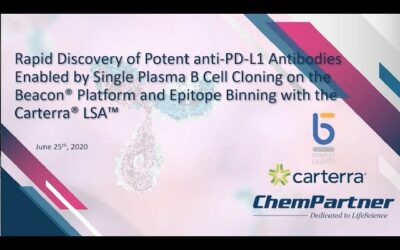
Rapid Discovery of Potent anti-PD-L1 Antibodies Enabled by Single Plasma B Cell Cloning on the Beacon Platform and Epitope Binning with the Carterra LSA
Presented by Dr. Shrieen Khan, Senior Director of Biologics at ChemPartner
Abstract:
- Antibody discovery in weeks versus years
- Isolate, culture, and assay tens of thousands of single cells with the Beacon platform
- Survey the epitope landscape of your antibody panel at the earliest stages of discovery with the Carterra LSA
PD-L1 is a key inhibitor of T cell activation that is often over-expressed in cancer to escape immune surveillance and promote tumor progression. Blocking antibodies against PD-L1 or its receptor, PD-1, have shown significant clinical benefit in some patients with PD-L1 expressing tumors. Hence, there is great interest in generating therapeutic antibodies against these targets to counteract the immune suppression mechanism that tumors rely on for survival.
Epitope binning studies on the Carterra LSA revealed that hybridoma antibodies covered more diverse epitope regions but potency in functional assays was weaker across all bins while B Cell Cloning antibodies were concentrated in fewer epitope bins that represented greater potency.
Our data show that plasma B cells secreting functional antibody candidates can be rapidly identified on the Beacon compared to several months for a hybridoma campaign and screening those antibodies for epitope specificity and affinity can be completed in just days on the Carterra LSA, thus substantially accelerating the antibody discovery process.

Drug Discovery Advanced with Modern Externalized Models
Presented by Dr. Sarah Lively, Vice President of Innovation and New Technology at ChemPartner
Abstract:
The world of external support to advance drug discovery has changed dramatically in the last 20 years. We are now in a position where we can truly rely on external partners to ‘get the job done’ and can run our programs almost entirely virtually from early target validation all the way through IND enabling studies, FIH, and beyond. This talk will explain some of the newer working models of support and the innovative ways service providers are finding to support their customers. In particular, it will focus on the science around select case studies in oncology and neuroscience where ChemPartner has partnered with groups to push projects efficiently to a key inflection point.
These case studies will showcase the key decision-making criteria biopharmaceutical companies use to determine their ‘partner of choice.’ Additionally, we’ll review the kinds of high-end science that pharma and biotech companies can now find outside of their own walls and how groups can come together to achieve common goals. Lastly, we’ll discuss ways to form strategic partnerships with different groups in a real ‘win-win’ scenario where all partners participate in the upsides of success. This goes beyond traditional ‘risk share’ which are more ‘risk mitigation’ strategies on the part of groups looking to parse off risk where outcomes are less certain, but more where savvy groups come together for mutual benefit and true and lasting partnerships form.
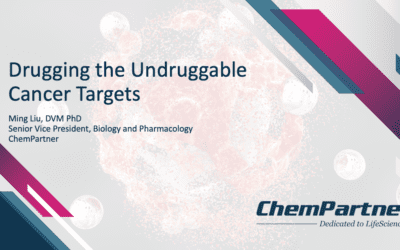
Drugging the Undruggable Cancer Targets
Presented by Dr. Ming Liu, Senior Vice President of Biology and Pharmacology at ChemPartner Abstract:
Cancer is a multifactorial disease, and its genesis and progression are extremely complex. The scope of precision oncology is rapidly expanding to address previously undruggable targets. The term “undruggable” was used to describe proteins that could not be targeted pharmacologically. Many targets in cancer research fall into this category, including KRAS, which has eluded researchers for more than 30 years until recent landmark discoveries of AMG 510, MRTX 849, and BI 1701963. As clinical trials are vigorously advanced, efficacy, safety, resistance, and combination strategies are being carefully evaluated for those drug candidates. In addition to KRAS, there are other challenging targets such as P53, MYC, fusion transcription factors, immuno-suppressors,…etc.
The focus of this webinar is to provide an overview of strategies in drugging some perceived undruggable targets, with stories and case studies by scientists who strive to find these medicines and fill unmet patient needs.
Experienced in overcoming prior hurdles to find effective antagonists against cancer, as a R&D CRO, ChemPartner has utilized a wide range of integrated approaches such as medicinal chemistry, antibody-drug conjugates, monoclonal antibodies, in vitro biology assays, cell biology, immuno-oncology, pharmacology, and combination therapy to identify and tackle the problems that surround drug development for “undruggable” targets.
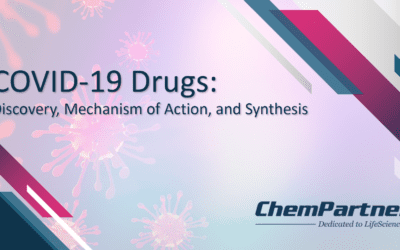
COVID-19 Drugs: Discovery, Mechanism of Action, and Synthesis
Presented by Dr. Jie Jack Li, Vice President of Discovery Chemistry at ChemPartner
Abstract:
COVID-19, an infectious disease caused by SARS-CoV-2, is now wreaking havoc in the US and around the world. Meanwhile, scientists are also making strides against the invisible enemy. Most notable are the recent success of remdesivir and demethasone.
This webinar, given from a chemist’s perspective, covers the discovery, mechanism of action, and synthesis of remdesivir and demethasone. It is most relevant to medicinal and process chemists. But anyone interested in drug discovery will find it highly informational as well.

The History of Cancer Drugs
Presented by Dr. Jie Jack Li, Vice President of Discovery Chemistry at ChemPartner
Abstract:
Anticancer drugs have experienced a revolution during the last decades with the emergence of kinase inhibitors as targeted drugs and immune-oncology. This webinar covers a history of small molecule anticancer drugs from the perspective of a medicinal chemist. It starts with a brief discussion of the etiology of cancer and then moves on to review eight classes of cancer drugs. All scientists in oncology, especially medicinal chemists, will find this webinar informational and entertaining.

Application of In-Vitro and In-Vivo ADME/PK/Exploratory Tox Assays to Support Lead and Candidate Selections
Presented by Dr. Lilly Xu, Ph.D., Senior Vice President, DMPK & Exploratory Toxicology at ChemPartner
Topics Discussed in this Webinar are:
- In-vitro ADME and tox assays
- In-vivo PK/Expl Tox assays
- Application of these assays for lead and candidate selections
- IND filing package summary

Bay Area Peptalks
Presented by: Manuel Sanchez-Felix, PhD, Senior Fellow, Novel Delivery Technologies Group at Novartis Institutes for BioMedical Research & Robert Tarran, PhD, President and CSO, Eldec Pharmaceuticals and Professor of Cell Biology & Physiology at the University of North Carolina at Chapel Hill (UNC)
Patient-centric design for systemic peptide delivery: Trends in routes of administration and advancement in drug delivery technologies
Abstract:
Utilizing peptides as therapeutic agents is considered an attractive approach for treating various diseases due to their high binding and selectivity to novel drug targets. However, the physicochemical properties of peptides make them challenging to administer exogenously, which places a high burden on drug delivery technology selection to successfully achieve the desired response. Various peptide drug delivery systems have been used in clinical and marketed products to overcome the problems associated with exogenous administration of peptide therapeutics. This presentation covers trends observed pertaining to the delivery of peptides such as changes in the routes of administration, advancements in formulation platforms, patient-centric product design, and various other aspects of peptide delivery. Harnessing the Lung’s Naturally Occurring Peptidome to Generate Novel Therapeutics Abstract:
Airway secretions contain ~1000 proteins and peptides that play important roles in regulating lung homeostasis. In many lung diseases including cystic fibrosis (CF), chronic neutrophilia and infection lead to an increase in free protease levels that induce protein/peptide cleavage, suggesting an impaired/altered functionality. Little is known about the peptidome of airway secretions. Here, we set out to define the normal and CF peptidomes and to use them as a drug library for future studies. We size-fractionated sputum from normal and CF subjects and studied these fractions by LC-MS/MS without conventional tryptic digestion in order to detect endogenously produced peptides. We identified ~130 endogenous peptides in normal sputum and ~700 peptides that were common to all CF patients. Interestingly, only 60 peptides were seen in both normal and CF subjects. Using principle component analysis and k-means
clustering, we found that the normal and CF peptidomes were p<0.00013 different. Since little is known about the functionality of the normal and CF peptidomes, we utilized SPOT synthesis technology to make a library of these peptides that included the entire normal and CF peptidomes. We then performed high content imaging using 384 well plates in order to determine whether these peptides could affect cell growth, cell Ca2 + and some other parameters including viral infection with respiratory syncytial virus and a pseudotyped SARS-CoV-2 S1 virus. Using this approach, we identified peptides that inhibited Ca2 + signaling, which Eldec is now developing as novel immunomodulatory peptides for lung diseases including pneumonia, asthma and fibrosis, and also identified novel antiviral peptides. These data indicate that peptidome screening is a feasible starting point for developing novel peptide-based therapeutics. — Funded by the NIH and North Carolina Biotechnology Center.

